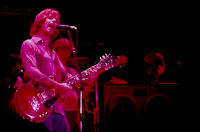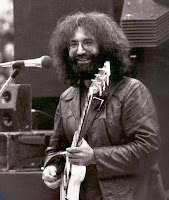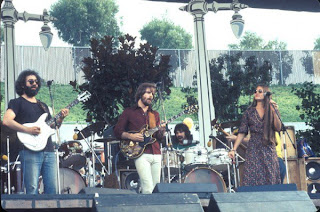Tuesday, September 6, 1983
Red Rocks Amphitheatre – Morrison, CO
Audience Recording
Man, I love finding great shows hidden in the early 80’s! It’s like panning for gold, knowing that there’s so much to wade through, only to come across a ten pound handful of the precious stuff. I got a nice unassuming nudge in this show’s direction from a decades long friend who was in attendance for this one, sitting in the sweet spot, and feeling that spot most completely. His fond reflections made me immediately curious about the show. About thirty minutes later I had tracked down two masters on the archive and had them at the ready to ride. Tip of the hat to the good old Internet tubes for that!
 You’ll often hear about “dream set lists” if you hang out with tape collecting Deadheads long enough. We just like talking about this stuff. There are two kinds of dream set lists: actual, and fantasy. 09/06/83 can easily be describe as an actual dream set list. The planets just align for us. Challenged to create a 1983 set list yourself, this one would be somewhat of a long shot. But, if you’re going to get a Dupree’s, Bird Song, and Lazy Lightning in a 1983 first set, you know you are well on your way. When you follow up with a star studded, waste no time second set that tosses in an Uncle John’s and a Brokedown, you’re there.
You’ll often hear about “dream set lists” if you hang out with tape collecting Deadheads long enough. We just like talking about this stuff. There are two kinds of dream set lists: actual, and fantasy. 09/06/83 can easily be describe as an actual dream set list. The planets just align for us. Challenged to create a 1983 set list yourself, this one would be somewhat of a long shot. But, if you’re going to get a Dupree’s, Bird Song, and Lazy Lightning in a 1983 first set, you know you are well on your way. When you follow up with a star studded, waste no time second set that tosses in an Uncle John’s and a Brokedown, you’re there.After warming up with some standards that sometimes manage to go to some twisted little off ramps (check the vocal weirdness on Peggy-O), the second half of the set begins with Bird Song. Ever the set one dose of wonderful, spacey exploration, Bird Song lives up to its reputation. It overflows with a crazy level of energy. Not frenetic are frenzied, but wildly crazy just the same. They push out all the boundaries imaginable. It is a dance that defies a body’s ability to express it, a symphony that has been written in six different directions. It is ever-lifting, and any time you think it might come down, it doesn’t. It’s wonderful. It will scramble your senses, leaving you ready for so much more.
 The Supplication borders on Other One intensity at times. A churning ball of cosmic fire, Bobby plays very aggressively. Brent hammers away. And Jerry is spot on as he seems to run a serpentine course in four dimensions, maybe five. At times his leads hover in the cloud of the other players’ sharp and pointed voices, Then he swoops out and down in impossible arcs to crackle like liquid lightning (nothing “lazy” here) across the face of the crowd. His seductive riffs beckon us to follow him back into the cloud, but the onslaught of the rest of the band is at times too intoxicating in its own right. We are left hopelessly at the mercy of the entire picture, unable to rest our eyes on just one color or abstract shape before it morphs into another.
The Supplication borders on Other One intensity at times. A churning ball of cosmic fire, Bobby plays very aggressively. Brent hammers away. And Jerry is spot on as he seems to run a serpentine course in four dimensions, maybe five. At times his leads hover in the cloud of the other players’ sharp and pointed voices, Then he swoops out and down in impossible arcs to crackle like liquid lightning (nothing “lazy” here) across the face of the crowd. His seductive riffs beckon us to follow him back into the cloud, but the onslaught of the rest of the band is at times too intoxicating in its own right. We are left hopelessly at the mercy of the entire picture, unable to rest our eyes on just one color or abstract shape before it morphs into another.Set Two explodes with the opening Help>Slip>Frank. The Slipknot ambles beautifully in coolly flowing patterns which eventually find Bobby and Brent bathing the music is nearly blinding fog blankets of sound swells. These ease off, and Jerry’s slow motion corkscrew continues to draw us along from there.
 Franklin’s Tower is an awesome ride, stacking one better lead section on another. It goes in and out of the verses is like a warm summer storm that rises and falls on the wind as it passes overhead. Eventually Jerry nears hurricane stature in the last solo, and beams of white hot light ignite the air around you. Then the storm recedes, leading us to an fantastically psychedelic and creative Playin’ In The Band.
Franklin’s Tower is an awesome ride, stacking one better lead section on another. It goes in and out of the verses is like a warm summer storm that rises and falls on the wind as it passes overhead. Eventually Jerry nears hurricane stature in the last solo, and beams of white hot light ignite the air around you. Then the storm recedes, leading us to an fantastically psychedelic and creative Playin’ In The Band.This Playin’ starts stretching it’s legs with Jerry working the wha wha in somewhat un-1983-like fashion. Under him, Brent is laying out huge moaning drones that fill the air with an endless expanse of timelessness. Phil works his way into this some as well. This is really nice stuff. Eventually Jerry settles into his more staccato lead style, and Brent works into a sound that feels like a wooded steel drum. Bobby is setting off flare-like bursts, and everything starts bobbing and weaving around you. Soon thereafter, Mickey is angling into a pre-Space style of drumming, smacking tones and riffs from impossible angles to the beat. Things are slipping so far from a traditional Playin’ jam, you have to wonder if they are cutting the jam short to let the drummers go. Not at all.
 Jerry rounds us all the way back to the Playin’ theme and the band draws to a hush. Now Billy is queuing the start of Drums. No doing. We’re barley half way through. From here the music cracks all molds and fractures into chaotic reflections of different dimensions. It grows more aggressive, and Phil is pulling some semi-frightening groans from the mountains around you. An unexpected melodic cohesion appears, and above it Bobby starts working a slide behind his guitar pickups. This produces bird like chirping that grows to subtle screaming. Then the entire mass of music flies out of any semblance of song structure. Bobby leads this weirdness too, with his own deep swelling dissonant groans. The music finally trails off leaving you on the shores of Drums and Space.
Jerry rounds us all the way back to the Playin’ theme and the band draws to a hush. Now Billy is queuing the start of Drums. No doing. We’re barley half way through. From here the music cracks all molds and fractures into chaotic reflections of different dimensions. It grows more aggressive, and Phil is pulling some semi-frightening groans from the mountains around you. An unexpected melodic cohesion appears, and above it Bobby starts working a slide behind his guitar pickups. This produces bird like chirping that grows to subtle screaming. Then the entire mass of music flies out of any semblance of song structure. Bobby leads this weirdness too, with his own deep swelling dissonant groans. The music finally trails off leaving you on the shores of Drums and Space.A really nice Space takes form, as if the band was intrigued by the efforts in Playin’ and want to push things even further. Rather than sounding forced at all, everything works together very well. Jerry’s scales flow in more than sometimes meaningless directions, and around him wild swells of sound, like giant taffy rivers, crest their banks. Things go from totally strange to eerily melodic with Bobby and Jerry settling into a duet. It floats back and forth from strange to subdued until eventually coming out on the other side into Uncle John’s Band.
A winner in almost any show from any year, Uncle John’s begins a truly delightful post Drums/Space set of music. Just as we were wrapped in non-1983 passages during Playin’, UJB simply exudes all things Grateful Dead and defies simple assignment to any one year. It’s smile producing all around. The Playin’ reprise ties up the loose ends and drops directly into Throwing Stones.
 Not to be missed, the jam section of this tune departs everything remotely resembling the song itself (much like the Playin’ earlier). It’s short lived, but extremely unexpected and enthralling as the entire song is dismantled and lit on fire. Topping it off by nailing the return to the song proper, the band seems in no mood to let anything go off without some extra oomph.
Not to be missed, the jam section of this tune departs everything remotely resembling the song itself (much like the Playin’ earlier). It’s short lived, but extremely unexpected and enthralling as the entire song is dismantled and lit on fire. Topping it off by nailing the return to the song proper, the band seems in no mood to let anything go off without some extra oomph.Not Fade Away doesn’t disappoint in this regard either. The energy is high, and the song high-steps along, brimming with energy. The crowd chants long after the band stops playing, on the way to the Brokedown Palace encore. This caps the evening with that ever loving embrace which pervades the joy of Grateful Dead music throughout time.
This show strikes me as very special, and even more so when juxtaposed against the mainstream music of the day. It was the Summer of Flashdance, Dexy’s Midnight Runners, and right there at the top of the charts in September 1983, Men Without Hats’ Safety Dance.
Nestled in the Red Rocks theater, I’d say it was a somewhat more preferable scene.
There are a couple of good AUDs up on the archive for this show. Front to back, despite some odd track ID starts (the track labeled "Drums" starts at the begining of the Playin' jam), this one recorded with Beyer microphones seems to please my ears the most. Nice highs and lows:
The other recording up there, recorded with Sennheiser's, has a great sounding second set that offers a bit more midrange, if your tastes lean more this way.


















 I’m linking to my original gdADT copy here.
I’m linking to my original gdADT copy here.









